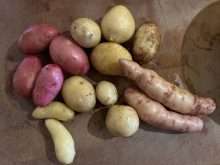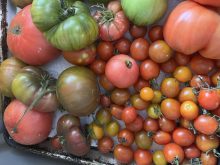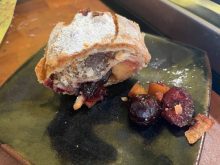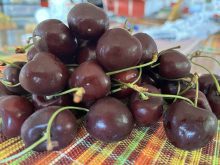We live a long way from peach country, the wine-and-fruit-specialist Okanagan and Similkameen valleys in B.C.’s deep south. Those two B.C. valleys are home to twice as many fruit growers as Ontario and Quebec combined, and StatCan sets the province’s fruit production at over $450 million annually.
Each summer, one fruit grower, Little Quail Orchard at Oliver, B.C., makes regular long-haul drives with a reefer truck filled with fruit to sell at farmers’ markets in and around Saskatoon. Their fruit is spectacular, juicy, intensely flavoured and worth waiting for — worth going without lesser fruit until the truck’s arrival each summer.
But climate change is dictating shifts in weather patterns: the 2021 heat dome, and several years of extreme cold, have put B.C. fruit and grape crops at a crossroads. In 2024, an extreme January cold snap saw temperatures plunge to -27 C, unheard-of in the fruit belt, killing grapevines and buds on stone-fruit trees. Our Little Quail orchardist told me on their first trip to the Prairies earlier this summer that there would be no peaches, no apricots, no nectarines, no plums this year. Like other growers in the region, they are pivoting, putting in hardier crops. Their tables on that first visit held only cherries. On subsequent trips, new-crop apples, strawberries and melons have appeared.
Read Also

Gentle treatments for pain in the neck
Heading toward year-end, people unknowingly tense up against the cold and busyness, causing neck pain that can often be treated with appropriate support and gentle mobility, athletic therapist Kathlyn Hossack says.
Peaches such as Little Quail grows are among my favourite fruits, and like other fruit lovers, we have been mourning their loss, and hoping this doesn’t signal the end of B.C. stone fruits. In their absence, locally grown raspberries have become more precious than ever. The glorious rainfall that preceded summer set up the situation for a bumper crop of berries in my mother’s raspberry patch, and like other cooks, I have been casting about for the best ways to make the most of the red berries.

We have enjoyed fresh berries and raspberry syrup on waffles. We’ve enjoyed raspberry and rhubarb cobbler, raspberry and apple crisp and crepes, raspberry and apple galettes, muffins, raspberry and white chocolate scones, raspberries layered in cake, raspberry fool, vinaigrette, coulis, barbecue sauce, salads, jams, and raspberry-ginger lemonade. Bottles of raspberry vinegar are steeping in in my cupboard. But my favourite raspberry dessert to date is the seedless raspberry ice cream I served with flourless chocolate cake to mark my eldest son’s birthday.
First we eat, then we say thank you for the berries, and thanks to the growers who feed us as best they can.

Seedless raspberry ice cream with chocolate flakes
This is a two-day project with chilling time required, so start early. Adding alcohol to the fruit puree lowers the freezing point, making the ice cream softer and easier to scoop. Add too much booze and the liquid won’t freeze, so don’t exceed several tablespoons per quart unless you’re aiming to make a boozed-up slushy. If you prefer, leave in the raspberry seeds, but trust me: the luscious finished texture is worth the effort of removing them.
Makes about 1 quart.
- 6-8 cups raspberries, fresh or frozen
- pinch of salt
- 1 ½ cups sugar
- 1 tsp. lemon juice
- 1 Tbsp. brandy
- 1 ½ cups milk
- ½ cup whipping cream
- 6 large egg yolks
- ½ lb. dark chocolate, finely chopped
- 2 Tbsp. coconut oil
Freeze the ice cream maker’s cannister at least one day in advance.
Combine the berries, salt and ½ cup sugar in a large bowl. If the berries are frozen, break them apart, mix well and let stand. When thawed, macerate in the sugar for an hour. Mash thoroughly. Put the mixture through a food mill or fine-mesh sieve, using a rubber spatula to press down and extract the pulp and juices. Use the spatula to scrape the sieve’s outside to capture all the puree. Discard the seeds. Add lemon juice and brandy to the puree. Cover and chill overnight.
Heat ½ cup sugar with milk and cream in a heavy-bottomed pot. Bring to a simmer. Whisk the remaining sugar with the yolks in a medium bowl, beating until thoroughly blended. Set a fine-mesh sieve and a large bowl, two-thirds full of ice water, close to hand.
Add one-third of the heated milk mixture to the yolks and whisk vigorously, then add the remining milk mixture. Pour the mixture into the pot and cook over medium heat, stirring constantly with a spoon or spatula, not a whisk, until the custard thickens. Do not allow to boil: the temperature should not exceed 180-185 F.
Strain custard through the sieve into a clean bowl and position the bowl in the ice bath. Stir the custard as it cools. Cover and chill overnight.
Combine chocolate and coconut oil in a heatproof bowl and microwave on medium power for 2-3 minutes, stirring several times, until melted and blended. Set aside at room temperature.
Mix together the custard and the puree. Make ice cream as per your ice cream maker’s instructions. Stir in the chocolate and coconut mix at the last minute as the ice cream sets. Transfer to a freezer-safe container, cover and freeze overnight. Bring to room temperature for 15 minutes if necessary before serving.















